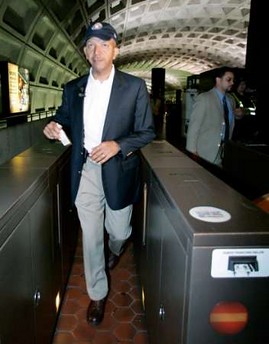Put on a happy face: DC's branch of the Growth Machine revisited
Song, Liza Minelli, "Put on a Happy Face," video

Washington D.C. Mayor Anthony Williams leaves a Metro train station after riding a train in Washington July 8, 2005. Williams rode the train to demonstrate safety in Metro stations after bomb blasts rocked the subway system in London on Thursday. REUTERS/Larry Downing
Even though former Mayor Anthony Williams was put into office by "the Growth Machine*," he did a lot of good for the city of Washington by refocusing municipal government on providing quality services, (re)building up the land use and transportation planning functions, creating a Department of Transportation separate from the DPW, embarking on streetscape programs, creating the Main Street commercial district revitalization program, and revitalizing the DC Housing Authority, among many other initiatives.
Not that Mayor Williams was perfect. Many quarters criticize him as leading the charge for gentrification and displacement (a/k/a a neo-liberalism agenda).
------------
I think that the GM thesis is better at explaining why the elites do what they do while the UR thesis is better at explaining how they do it. See the past blog entry "A superb lesson in DC "growth machine" politics from Loose Lips (Washington City Paper)" for a longer discussion of the two theories. From the blog entry:
In discussing Atlanta, Stone writes: "Land use, transportation, and housing formed an interrelated agenda that the city's major economic interests were keen to advance;" and
By looking closely at the policy role of business leaders and how their position in the civic structure of a community enabled that role, he identified connections between Atlanta's governing coalition and the resources it brought to bear, and on to the scheme of cooperation that made this informal system work. In his own way, Hunter had identified the key elements in an urban regime – governing coalition, agenda, resources, and mode of cooperation. These elements could be brought into the next debate about analyzing local politics, a debate about structural determinism.
-------------
I guess given how much the quality of local governance has declined since Mayor Williams left office, both during the Fenty regime, and now under Mayor Gray and the multiple ethics and governance failures of the City Council, the Federal City Council is looking to have a more mature and able hand "on retainer," to steady the course of local governance.
-- "THE DISTRICT'S POWER BEHIND THE SCENES: Washington Post-connected business group wields influence over city's legislative agenda," 1999, The Common Denominator
-- "The DC Lobby," 2002, The Common Denominator
-- ANALYSING THE CHANGE IN LOCAL GOVERNMENT: Perspectives of the Regime Theory and the Growth Machine Thesis, 1998
-------------
As a close observer of the city but not yet involved in local civic affairs before Mayor Williams was elected, I think what is most interesting about his election is that few if any advocates and observers (including me) understood what a sea change his election would bring in terms of changing the city's investment climate, which had become increasingly risky under Marion Barry's leadership, despite his doing just about whatever real estate interests wanted (see chapter four of the book Dream City), culminating in the federal government's takeover of the city's finances in the mid-1990s, because the city was on the verge of bankruptcy.
Co-incident with this were two other key elements (1) the reaching of critical mass in terms of interest and willingness to live in the city despite all its problems (I joke but believe that this had to do with, in large part, tv shows like "Friends" and "Seinfeld" which were pro-city, while previous shows like "The Brady Bunch" were pro-suburban) and (2) the region, and especially DC, exiting the 10 year period of relative recession within the local real estate market--DC's housing market peaked around 1988 and then went into recession for about 10 years. (Also see my 2003 piece in the Philadelphia Daily News, "An outsider's version for saving Philly," which compared the urban revitalization climates in DC and Philadelphia at the time.)
Because government functions in planning especially, along with civil society and capacity building institutions withered during the Barry years, neighborhood advocates and city regulations were unprepared for the "velocity of change" in real estate development that would be unleashed by the election of Anthony Williams, and the creation of a more stable climate for real estate investment.
Not having good plans for Housing (including equity), but especially, not having fully robust planning and land use regulations in place in advance of the unleashing of pent up economic activity meant that residents were for the most part, without the tools in place that they needed to ensure that better projects would be created.
That can't be blamed on Anthony Williams.
And while the planning function was significantly improved under Mayor Williams, the city still lacks the right planning and regulatory framework necessary to better shape the changes that are going to continue to happen as the city continues to be an ever-improving place to live and work and play (if the elected officials don't f* it up too badly, but I am just not sure yet if the environment for improvement is strong enough to withstand rounds of bad decision making).
The debacle over Walmart is a perfect example. Neighborhood and union forces clamored for a "community benefits agreement," but really what the city need/ed/s is a "big box zoning overlay," to trigger extra-normal review of such projects to mitigate potentially negative impacts. Such provisions are still missing in the city's regulatory toolkit.
Labels: electoral politics and influence, Growth Machine, real estate development, urban regime



0 Comments:
Post a Comment
<< Home